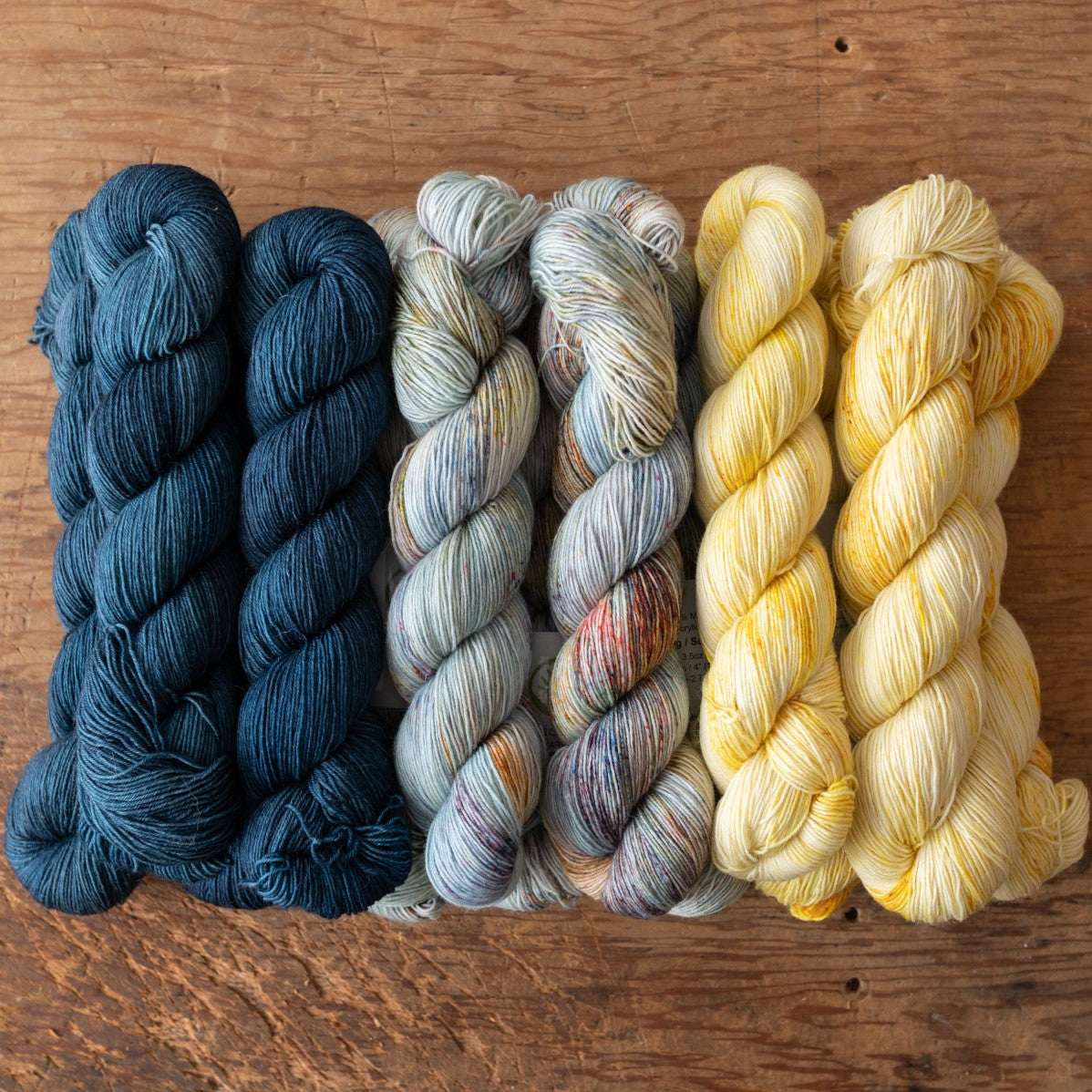Ancient Arts Yarn is an Albertan company that hand-dyes an incredible range of beautiful yarns. We’ve brought their Revival base into our store in two custom colours--a soft, sunshine yellow called Sweet Clover and a deep indigo called Pond--as well as a complementary speckled blue called Cezanne.
Revival is a remarkable yarn base. It’s strong and soft, suitable for both warp and weft, with good body and a slight halo. But Revival is also remarkable for how it’s made: fibres that would otherwise be sent to the landfill are gathered from the carding machines at a large mill and combined to create a distinctive wool blend. This yarn is both beautiful and eco-friendly, dyed locally and great to weave with. Gather caught up with Caroline Sommerfeld, Chief Yarn Officer at Ancient Arts, to talk dyeing, yarn blends, and weaving.

Gather: Ancient Arts Yarn is well known in the knitting world, but I believe you’re also a weaver?
Caroline: Yes! I’ve got some rigid heddle looms, and that’s where I do my weaving with the hand dyed yarn. I bought my first rigid heddle loom back when Ashford first brought them out. When I started out I got the 32” model because bigger is better, right? (laughs) And then finally got a smaller one, which is more comfortable for scarves and tea towels.
Gather: Sometimes people talk about knitting yarn and weaving yarn like they’re totally separate things. What differences do you see between yarns that knitters like and yarns that weavers like?
Caroline: There was a trend in the knitting world that started about ten years ago where people got into superwash yarn. Speckles and super saturated colours got popular, and it’s much easier to dye precise, saturated jewel tones on superwash. That’s where knitting and weaving yarns started to diverge. Weavers also need yarn that’s a bit stronger, so when we source yarn for weavers we watch out for structures that have higher twist and number of plies. Things like singles yarns are fine to weave with if they have a high enough twist—all the bodies of bog people are wearing things woven from singles yarn—but the modern day knitting yarns are obviously made with a very soft twist.
As a multi-craft maker. I make sure we have yarn bases that cross over both knitting and weaving.

Gather: What considerations go into designing a yarn for weaving in terms of colour? Are there certain lengths of repeats in a variegated yarn that work particularly well for weaving?
Caroline: I’m very influenced as a weaver by things like ikat traditions, and I really like the yarn to do some of the work for me. I really enjoy seeing the yarn just do the speaking. The yarn I like to weave with will produce some kind of patterning, by lining up colour repeats in either the warp the weft or both. I’ve done some pieces myself where I combine a stripey warp and a plain weft, and you get these lovely patterns that are quite easy to make.
When you weave something and you put colours together they behave differently than you do when you knit them. Having some experience of weaving helps me when I’m designing. If you’re not careful the colours can turn to mud really easily, or you can just lose colours. I wove with chenille once, and I was bloody minded stubborn to be honest. I chose a browny gold, and orange and a red. It was a really good object lesson in what happens when you weave things together. It was mud.
Gather: So when you plan colours for a weaving yarn, you’re trying to keep colours more distinct?
Caroline: Either keep them distinct or if they’re going to optically blend in the weaving you want to keep them from turning into brown or grey. There are some combinations I love on the skein, but once you weave with them they turn grey. When you get too many complementary colours close together they turn grey. For example yellow and purple together will turn grey. If you put small dots of those colours together then you’re going to have trouble because from a distance they grey out.
In weaving you’re mixing yarns in both directions so you can have to be careful. When you knit a one-inch section you get one stitch out of it, maybe two. When you weave, it will be a much longer stripe. It does some really cool things, but if you want the colours to be more distinct you need a longer stripe.
Something with medium-length colour stripes as a warp is great, but for the weft it really breaks up the colours. If I have a weaving store asking for colours, I will choose colourways with longer repeats. Longer repeats of colour will show better in weaving.

Gather: That’s really cool! Can I ask about the yarn base? The Revival base uses fibre that would otherwise be wasted, right?
Caroline: Yes! The way that it works is that at the mill we work with they have these gigantic carding machines. They load them up with fibre and card it to get ready for spinning. Once they’ve done the production run, there’s all this fibre left and they have to clean it out of the machine. And what’s a giant mill going to do with that fibre? They need a minimum of 300 kilos of fibre to do a run of yarn. So a lot of mills will just throw it out. It goes into the landfill. I was looking for a reclaimed or recycled yarn, and this mill said we’ve got all this stuff we get off the carder, we can save it up and card it. They saved it up for a year and it ended up being a hundred thousand pounds. A hundred thousand pounds of fibre would have ended up being thrown away if it wasn’t for that!
Each time I buy the reclaimed fibres yarn, the proportions will be different. Because they fibre test it, and the proportions change slightly each time. This worked out really well because what was going through that mill was the kind of yarn I wanted anyway. The only thing that I wouldn’t have chosen was the 2% acrylic, but at least we kept that out of the landfill. Sometimes we get batches that are a little too light on wool or a little too heavy on mohair, and we blend it with additional fibre so we still get something that’s nice to use. Because the mill specializes in mohair, we get a fair amount of mohair in the yarn.
But I also know as a hand spinner that mohair adds a lot of character to the yarn. It adds strength, it adds lustre, and it actually contributes to the structure of the finished cloth. It doesn’t felt like yarn, but it sticks to itself. So the yarn won’t slither all over when you weave. And helps with the stability. It’s almost like having a temple—it makes it easier. That’s my personal experience.
Revival has a higher twist to keep it from dumping mohair everywhere at you. When you finish it, you’ll get just a little bit of a nap forming from the fibres in the yarn but the twist keeps it from falling out. With mohair content in a yarn you can get that lovely soft finish on it.
It’s very important to me, as someone who has studied fibre extensively, that the reclaimed fibre makes a good yarn. We still keep the end user in mind.
This yarn is not overly elastic, which means there is a lot less draw in. With beginner weavers using a yarn that’s overly elastic, you get a lot of draw in and frustrated weavers. You can of course still get draw in with Revival if you don’t lay it in properly, but not as bad.

Gather: Is there anything else you want to share about your design process?
Caroline: Well, one of the things I really enjoy as a dyer, and that I tried to do with the colours I did for Gather is to put an element of watercolour painting in it. My mother was an artist and she taught me to paint a lot of really ugly landscapes that nobody else would ever want, but I got really fascinated with water colour process.
Gather: That’s fascinating. Why do you think watercolour goes so well with fibre arts?
There are some real similarities. You start off with a white or a natural yarn, and then you put down layers of colour. I work from an artistic perspective making my own colours and layers. What is the story behind each colour? When I did the blue for Gather I was thinking of indigo and the whole history of textiles dyed with indigo.
The blue (Pond) has seven layers of dye on it, so it has that real luminosity. With the yellow (Sweet Clover) it has five layers of dye, but the idea was to let the white yarn speak through the dye, the same way that watercolour paintings let the white paper speak through the paint.
To experience Caroline’s colours for yourself and try out the eco-friendly yarn base, check out our Revival Fingering/Sock Weight from Ancient Arts Yarn.

